- ¿Qué es un parque nacional?
-
- Mar de las Calmas (propuesta)
- Aigüestortes i Estany de Sant Maurici
- Cabrera Archipelago
- Cabañeros
- Caldera de Taburiente
- Doñana
- Garajonay
- Atlantic Islands of Galicia
- Monfragüe
- Ordesa y Monte Perdido
- Picos de Europa
- Sierra de Guadarrama
- Sierra de las Nieves
- Sierra Nevada
- Tablas de Daimiel
- Teide
- Timanfaya
- La Red de un vistazo
- ¿Cómo funciona La Red?
- Cartography
- Central Booking
Transectos: Muelle Titán
Transectos: Muelle Titán
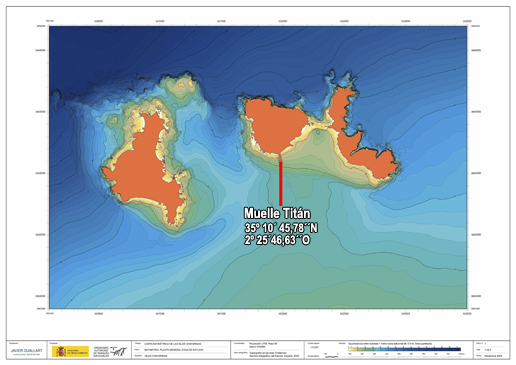 Resumen de las observaciones realizadas en cada metro de profundidad en Muelle Titán (Chafarinas). Autor: Luis Sánchez Tocino. Universidad de Granada
Resumen de las observaciones realizadas en cada metro de profundidad en Muelle Titán (Chafarinas). Autor: Luis Sánchez Tocino. Universidad de Granada
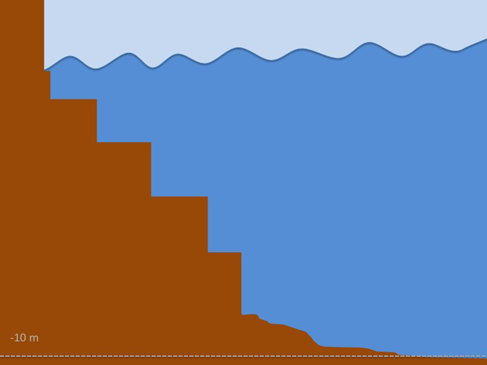 Representación del relieve del terreno en el Muelle Titán
Representación del relieve del terreno en el Muelle Titán
 El muelle “El Titán” fue construido a principios del siglo XX dentro de las mejoras del puerto de Chafarinas. Para su construcción se utilizaron bloques de hormigón y bloques naturales extraídos de las canteras de las islas. En esta zona es donde, prácticamente, se concentra la actividad de pesca deportiva con caña.
El muelle “El Titán” fue construido a principios del siglo XX dentro de las mejoras del puerto de Chafarinas. Para su construcción se utilizaron bloques de hormigón y bloques naturales extraídos de las canteras de las islas. En esta zona es donde, prácticamente, se concentra la actividad de pesca deportiva con caña.
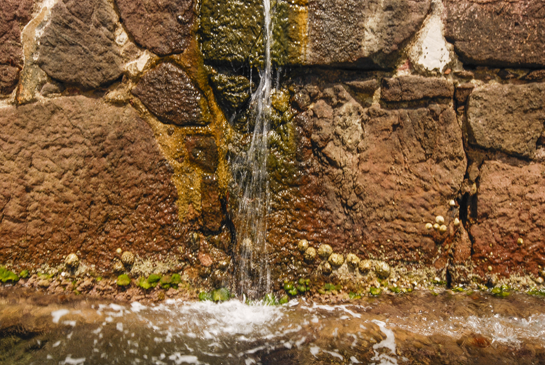 0m. La lapa Patella ferruginea predomina en el mediolitoral superior del Muelle Titán.
0m. La lapa Patella ferruginea predomina en el mediolitoral superior del Muelle Titán.
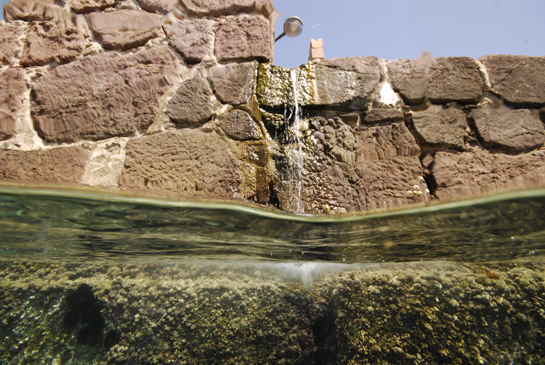 0m. El chorro de agua que cae del muelle procede de la planta desalinizadora.
0m. El chorro de agua que cae del muelle procede de la planta desalinizadora.
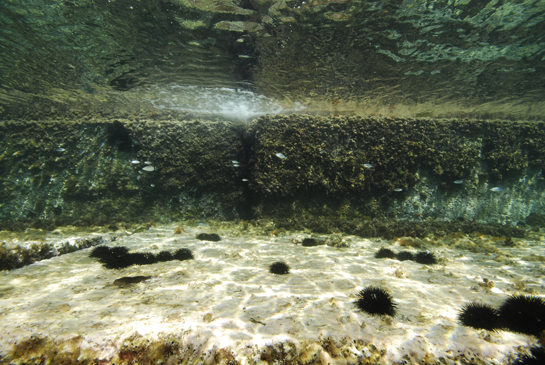 -1m. El ramoneo de los erizos, principalmente el erizo negro (Arbacia lixula) y el erizo común (Paracentrotus lividus), limita el crecimiento de las algas al de especies coralinas incrustantes. Al fondo nada un grupo de obladas Oblada melanura.
-1m. El ramoneo de los erizos, principalmente el erizo negro (Arbacia lixula) y el erizo común (Paracentrotus lividus), limita el crecimiento de las algas al de especies coralinas incrustantes. Al fondo nada un grupo de obladas Oblada melanura.
 -2m. La disminución de la luz, que se produce en las paredes verticales y en las uniones entre bloques, permite el asentamiento de varias colonias del coral naranja Astroides calycularis. Los peces negros de la izquierda son castañuelas Chromis chromis, en la parte superior, de color plateado, una oblada Oblada melanura y a la derecha un fredi o pez verde Thalassoma pavo.
-2m. La disminución de la luz, que se produce en las paredes verticales y en las uniones entre bloques, permite el asentamiento de varias colonias del coral naranja Astroides calycularis. Los peces negros de la izquierda son castañuelas Chromis chromis, en la parte superior, de color plateado, una oblada Oblada melanura y a la derecha un fredi o pez verde Thalassoma pavo.
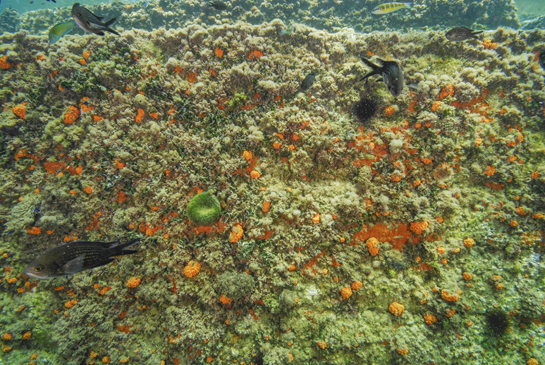 -3m. En primer plano nadan varias castañuelas Chromis chromis y por detrás destacan entre las algas, por sus llamativos colores, varias colonias del coral naranja Astroides calycularis, las esponjas rojas y el alga verde, con forma globosa, Codium bursa.
-3m. En primer plano nadan varias castañuelas Chromis chromis y por detrás destacan entre las algas, por sus llamativos colores, varias colonias del coral naranja Astroides calycularis, las esponjas rojas y el alga verde, con forma globosa, Codium bursa.
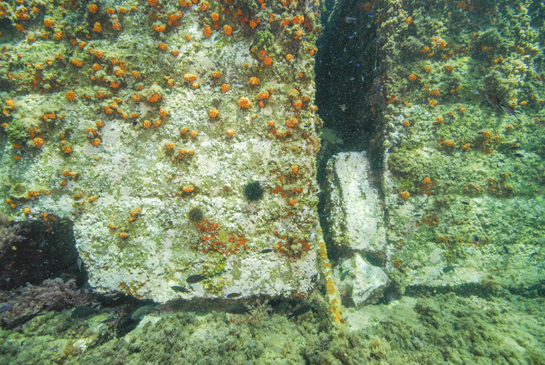 -4m. En la parte inferior izquierda vemos varios ejemplares de algas invasoras del género Asparagopsis.
-4m. En la parte inferior izquierda vemos varios ejemplares de algas invasoras del género Asparagopsis.
 -5m. Aparte de los organismos anteriores podemos ver en esta imagen las esponjas Ircinia sp. y, de color negro, varios ejemplares de Sarcotragus spinosulus. Cerca de uno de ellos se aprecia un hilo de pescar.
-5m. Aparte de los organismos anteriores podemos ver en esta imagen las esponjas Ircinia sp. y, de color negro, varios ejemplares de Sarcotragus spinosulus. Cerca de uno de ellos se aprecia un hilo de pescar.
 -6m. En la parte horizontal del escalón predomina el alga parda fotófila Halopteris scoparia y en la vertical, aparte de esponjas rojas y pequeñas colonias de coral naranja Astroides calycularis, el alga verde esciáfila Flabellia petiolata.
-6m. En la parte horizontal del escalón predomina el alga parda fotófila Halopteris scoparia y en la vertical, aparte de esponjas rojas y pequeñas colonias de coral naranja Astroides calycularis, el alga verde esciáfila Flabellia petiolata.
 -7m. El alga parda Halopteris scoparia predomina en los fondos del muelle El Titán.
-7m. El alga parda Halopteris scoparia predomina en los fondos del muelle El Titán.
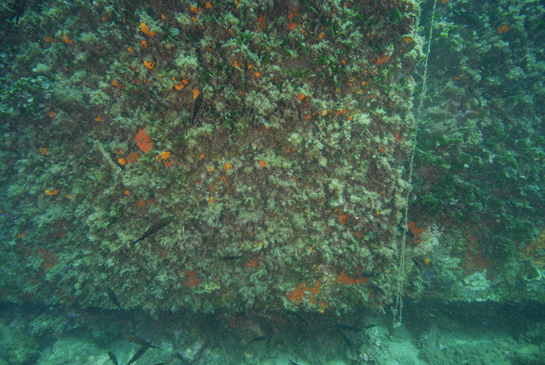 -8m. En la parte horizontal de los grandes escalones que forma la parte sumergida del muelle, los erizos, principalmente el erizo negro (Arbacia lixula) y el erizo común (Paracentrotus lividus), limitan el crecimiento de las algas al de especies coralinas incrustantes. En las paredes verticales, menos iluminadas, de los escalones se desarrolla una comunidad más compleja.
-8m. En la parte horizontal de los grandes escalones que forma la parte sumergida del muelle, los erizos, principalmente el erizo negro (Arbacia lixula) y el erizo común (Paracentrotus lividus), limitan el crecimiento de las algas al de especies coralinas incrustantes. En las paredes verticales, menos iluminadas, de los escalones se desarrolla una comunidad más compleja.
 -9m. En la base del muelle podemos encontrar algunas matas de Posidonia oceanica
-9m. En la base del muelle podemos encontrar algunas matas de Posidonia oceanica
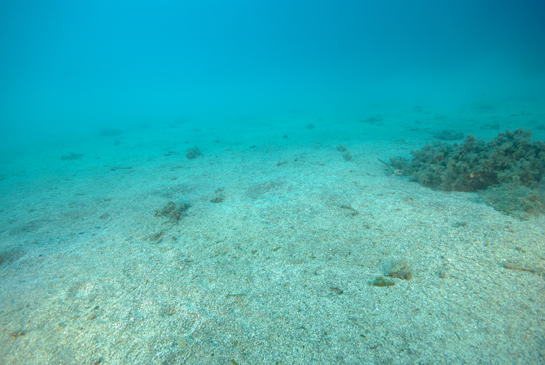 -10m. Una pradera de Posidonia oceanica rodea el muelle “El Titán” dejando un pequeño claro de fondo arenoso en la parte sur.
-10m. Una pradera de Posidonia oceanica rodea el muelle “El Titán” dejando un pequeño claro de fondo arenoso en la parte sur.
This page provides information on cookies we use: We use our own and third-party cookies to keep your session active, personalise your experience, and collect anonymous statistics about how you use this website. You can choose to accept all cookies or select which types you'd like to allow. To learn more about the cookies we use, read our Cookies Policy.
We use two types of cookies on this site. First, there are Functional Cookies, which are essential for the website to work properly. They store session data to make your experience smoother and more convenient. On the other hand, Analytical Cookies collect information about how you use the portal, without personal data, helping us provide a better and more tailored service.
Introduction to the Use of Cookies on the MITECO.gob.es Website
Cookies are small files that are stored on your device when you visit a webpage. They are essential tools that help provide many of the services available on the information society. Among other things, cookies allow a webpage to store and retrieve information about a user's browsing habits or their device. Based on this information, they can be used to recognise the user and enhance the service provided.
Types of Cookies
Depending on the entity that manages the domain from which the cookies are sent and processes the data, there are two types of cookies: first-party cookies and third-party cookies.
There is also a second classification based on how long the cookies remain stored in the user's browser: session cookies and persistent cookies.
Finally, cookies can also be classified into five types based on the purpose for which the data is processed: technical cookies, personalisation cookies, analytics cookies, advertising cookies, and behavioural advertising cookies.
For more information on this, you can refer to the Guide on the use of cookies from the Spanish Data Protection Agency.
Cookies used on the website
The web portal of the Ministry for Ecological Transition and the Demographic Challenge uses Adobe Analytics, an analytics tool that helps website and application owners understand how visitors interact with their content. Adobe Analytics uses a small number of cookies to collect data and generate usage statistics for websites. This information is sent anonymously and is not shared with third parties under any circumstances. You can choose to accept or reject these cookies, as they do not affect the portal’s functionality. However, they help provide valuable information that allows us to offer a better and more tailored service. For more information about Adobe Analytics cookies and privacy, please refer to the following links:
Additionally, pages featuring content from social network X will only set cookies if the user is logged into the X site. For more details on these cookies, please refer to the following link: Privacy on Social Network X
Finally, a technical cookie named MITECO-compliance is stored, which is a first-party, technical, and session-based cookie. It manages user consent for the use of cookies on the website, remembering which users have accepted them and which have not, ensuring that those who have accepted are not shown cookie consent messages at the top of the page. This cookie is essential for the proper functioning of the portal.
Cookies Policy Acceptance / Rejection
The Ministry for Ecological Transition and the Demographic Challenge gives you the option to accept or reject cookies that are not essential for the portal's operation. Upon accessing the portal, a message will be displayed in the centre of the page with information about the cookie policy and the following options:
· Firefox
· Chrome
· Safari